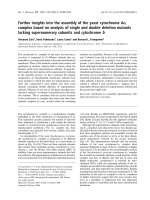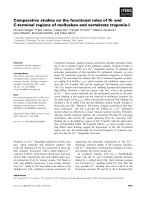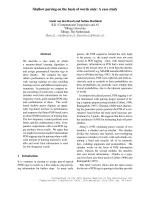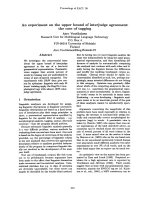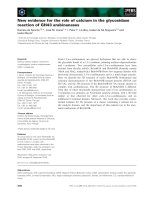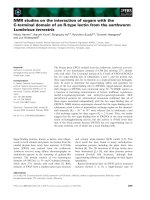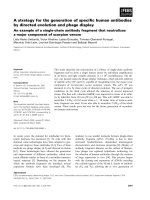Báo cáo khoa học: "An investigation on the presence of Chlamydiaceae in Swedish dogs" docx
Bạn đang xem bản rút gọn của tài liệu. Xem và tải ngay bản đầy đủ của tài liệu tại đây (231.91 KB, 4 trang )
RESEA R C H Open Access
An investigation on the presence of
Chlamydiaceae in Swedish dogs
Bodil Ström Holst
1,2*
, Sofia Hanås
3
, Göran Bölske
1
, Catharina Linde Forsberg
2
Abstract
Background: Bacteria belonging to the family Chlamydiaceae cause a broad spectrum of diseases in a wide range
of hosts, including man, other mammals, and birds. Upper respiratory and genital diseases are common clinical
problems caused by Chlamydiaceae. Very little is known about chlamydial infections in dogs. Few clinical reports
on natural disease in dogs describe mainly conjunctival and upper respiratory signs, and the role of Chlam ydiaceae
in genital disease is unclear. The present study aimed at studying the prevalence of Chlamydiaceae in healthy dogs
and in dogs with genital or upper respiratory disease, including conjunctivitis.
Methods: A real-time polymerase chain reaction (PCR) for Chlamydiaceae was used to detect any chlamydial
species within this family. Swab samples from the conjunctiva and the mucosal membranes of the oropharynx,
rectum and genital tract were taken from 79 dogs: 27 clinically healthy dogs, 25 dogs with clinical signs from the
genital tract and 28 dogs with conjunctivitis. There were 52 female and 27 male dogs. From 7 of the male dogs,
additional semen samples were analysed.
Results: No Chlamydiaceae were detected from any dog.
Conclusions: Although the number of dogs that was included is limited, the results suggest that cases of
Chlamydiaceae in dogs probably are related to infection from other species, and that dogs in general do not
harbour Chlamydiaceae. Bacteria belonging to the family Chlamydiaceae do not seem to be of major importance
for genital or ocular disease in Swedish dogs.
Background
Chlamydiae are obligately intracellular b acteria belong-
ing to the bacterial order Chlamydiales.TheChlamy-
diales comprises four families: Chlamydiaceae,
Parachlamydiaceae, Simkaniaceae,andWaddliaceae.
The family Chlamydiaceae contains two genera: Chla-
mydia and Chlamydophila [1]. Bacteria belonging to the
family Chlamydiaceae cause a broad spectrum of dis-
eases in a wide range of hosts, including man, other
mammals, and birds. Reproductive disturbances are
common, among them salpingitis in man (caused by
Chlamydia trachomatis), genitourinary disease in ko alas
(caused mainly by Chlamydophila pecorum) and abor-
tions in sheep and cattle (caused mainly by Chlamydo-
phila abortus) [2,3]. In cats there is also circumstantial
evidence for a role of Chlamydiaceae in reproductive
disturbances, and chlamydiae have been isolated from
the vagina of cats, e.g. [4]. Bacteria belonging to the
family Chlamydiaceae are also common ocular patho-
gens, for instance in humans (C. trachomatis),koalas
(Cp. pecorum) and cats (Chlamydophila felis). Avian
chlamydiosis, caused by Chlamydophila psittaci , occurs
worldwide and Cp. psittaci has been detected from a
wide variety of both wild and domesticated birds. Avian
chlamydiosis is the most important animal chlamydiosis
transmissible to man (causing respiratory disease;
ornith osis or psittacosis), but othe r chlamydiae, such as
Cp. abortus and Cp. felis, also have a zoonotic potential
[3], although Cp. felis infection in humans hitherto has
been verified in only one, HIV-positive, case [5].
Very little is known regarding the potential of Chla-
mydiaceae to cause genital or upper respiratory disease
including ocular disease in dogs. D etection of Chlamy-
diaceae requires special cultivation techniques, or analy-
sis with polymerase chain reactio n (PCR ), and therefore
these bacteria are seldom searched for in clinical cases
of genital disease or reproductive disturbances. Other
* Correspondence:
1
National Veterinary Institute (SVA), Uppsala, Sweden
Full list of author information is availabl e at the end of the article
Holst et al. Acta Veterinaria Scandinavica 2010, 52:63
/>© 2010 Holst et al; licensee B ioMed Central Ltd. This is an Open Acc ess art icle distributed under the terms of the Creative Commons
Attribution License ( which permits u nrestricted use, distribution, and reproduction in
any medium, provided the original work is properly ci ted.
aetiol ogical agents, such as canine herpes virus or extra-
cellular aerobic bacteria, that are known to have the
capacity of causing genital disease and reproductive pro-
blems in dogs, are searched for more frequently. Many
cases of conjunctivitis are also treated on an empirical
basis, without attempts to make an etiological diagnosis,
and if a causative agent is searched for, this is rarely
chlamydiae.
The aim of the present study was to study if members
of the family Chlamydiaceae can be detected on the
mucosa of healthy dogs, from dogs with reproductive
disturbances or geni tal disease, or from dogs with upper
respiratory signs including conjunctivitis. A real-time
PCR that detects all members of the family Chlamydia-
ceae was used. No Chlamydiaceae was detected from
anyofthe4-5samplingsitesfromthe79dogsinthe
present study.
Methods
Ethical approval
The study was approved by the Uppsala ethical commit-
tee for animal research (C 310/05) and by the Swedish
animal welfare agency (2006-0047). All dog owners gave
their informed written consent.
Dogs
79 privat ely own dogs of 41 differe nt breeds, five mixed
breeds and 5 with unknown breed, were included in the
study. There were 52 females and 27 males. They were
categorized as clinically healthy (N = 27), with clinical
symptoms from the genital tract (N = 25), or from the
upper respiratory tract, including ocular signs (N = 28).
One bitch was sampled twice, first with cystic endome-
trial hyperplasia (CEH)/endometritis and 2 years later
with conjunctivitis.
Signs from the genital tract included CEH/endometri-
tis or vaginal discharge (N = 12), pyometra (N = 6), vul-
var lesions (N = 1), poor semen quality (N = 1), failure
to conceive (N = 1), prostatic disease (N = 1), aberrant
oestrous cycles (N = 2) and balanoposthitis (N = 1).
Upper respiratory signs included conjunctivitis (N = 20),
conjunctivitis and cough or sneezing (N = 4), and only
cough or sneezing (N = 4). The dogs were sampled with
cotton tipped swabs without any transport or culture
medium. From each dog, four samples were taken: from
the conjunctiva, oropharynx, rectum and genital tract
(vagina or preputium) by rol ling swabs against the
mucosa. From male dogs, an additional fifth swab was
dipped in semen samples, when such a sample was
available (N = 7).
Real-time PCR analysis
At the laboratory, DNA was extracted from the swabs
for PCR analysis according to the protocol by Sachse
and Hotzel [6]. The samples were analysed using a
real-time PCR originally developed by Everett et al. [2],
which targets the 23 S ribosomal DNA and detects all
members of the family Chlamydiaceae.Wehavemodi-
fied this real-time PCR and developed an internal con-
trol to monitor any inhibition from the sample
material [7].
Results and discussion
Seventeen of the bitches (22%) were in heat and seven-
teen were in meto estrus. Of the 79 dogs, 27 (34%) were
stud dogs or breeding bitches. For 24 dogs (30%), pre-
vious reproductive disturbances or genital disease was
reported, and 26 dogs (33%) had previously had con-
junctivitis. No Chlamydia ceae were detected in any
sample.
The present study aimed at studying if healthy dogs or
dogs with genital or upper respiratory including ocular
disease harboured chlamydiae on their mucosa. In
chronically infected ewes, the periovulatory period has
been described to be optimal for detecting chlamydiae
[8]. To increase the possibility of detecting chlamydiae
in possibly inf ected bitches, several bitches (22%) were
sampled in heat. Despite this, Chlamydiaceae were not
detected from any of the samples.
Few seroepidemiological studies on chlamydiae in
dogs have been performed. In a Japanese study, using a
complement fixation test, 9.5% of dogs were seropositive
for Cp. psittaci, which was an even higher number than
for the cats in the same study [9]. There was also a
large variation in seropositivity between different dog
populations, from 0.9 to 17.4 per cent, with the highest
seroprevalence in a colony of experimental animals. In a
German study, using an enzyme-linked immunosorbent
assay (ELISA), 20% of the dogs were seropositive for Cp.
psittaci: 19.8% in a population of healthy dogs (N =
1028) and 26% of dogs with various clinical signs (N =
99) [10]. These results would indicate that infection
with chlamydiae is not unusual in dogs. However,
reports on naturally occurring chlamydial disease in
dogs are scarce. Conjunctivitis caused by Cp. abortus
has been described [11]. The source of infection could
not be traced, but as the dog was living on the country-
side, there were many possible infection routes directly
and indirectly from sheep [11]. Coughing, dyspnoea,
oculonasal discharge, pyrexia and anorexia caused by
Cp. psittaci have been described: two out of three dogs
in a household were infected, probably from a cockatiel
[12]. The humans also developed severe clinical signs
[12]. Cp. psittaci was also detected in a sample from a
dog from a colony of dogs experiencing recurrent peri-
ods of dyspnoea, keratoconjunctivitis and small litter
sizes and that had been kept together with a parrot and
two canary birds [13]. Humans from the same
Holst et al. Acta Veterinaria Scandinavica 2010, 52:63
/>Page 2 of 4
household also had recurrent respiratory disease [13].
From one clinical sample from a dog with unknown
clinical signs, Cp. caviae has been detected, a c ommon
chlamydial species in rabbits and guinea pigs, and from
samples from 4 dogs with conjunctivitis, Cp. felis was
detected [14].
A causative relationship between chlamydial infection
and genital tract disease has not been reported in dogs,
although small litter sizes were reported in a colony of
dogs in which Cp. psittaci was detected in a sample
from one of the dogs [13]. In an experimental setting,
inflammatory changes in the prostatic gland have been
induced by injecting C. trachomatis directly into the
prostatic gland [15] . The dogs ceased to excrete chlamy-
diae after 3-16 days and no chlamydiae could be grown
in tissue cultures, suggesting that the infection may have
been self-limiting. No case of naturall y occurring pro-
static disease due to chlamydiae in dogs has been
described, and no Chlamydiaceae were detected from
the dog with prostatic disease in the present study.
Although it has been sug gested that the dog might be a
model for chlamydial prostatitis [15] it does not seem
likely that chlamydiae are natural causes of canine pro-
static disease. Based on the scarcity of clinical reports,
and the lack of naturally occurring chlamydiae on the
canine mucosa found in the present study, chlamydial
infection is likely an uncommon cause of reproductive
disturbances in the canine species
Other clinical sign s experienced in dogs infect ed with
chlamydiae include hepatitis after experimental infection
[16], and a suspicion of septic polyarthritis, although
chlamydiae could not be cultured [17]. The organism
could, however, be isolated from another dog with pyr-
exia and shifting leg lameness [18]. Chlamydiae have
been isolated from pleural effusions of a dog referred to
a clinic for pyrexia and shifting leg lameness. The chla-
mydiae were classified as “ turkey strain” of Cp. psittaci,
and it was speculated that the dog had been infected by
an avian host [18].
Contact with another animal species infected with
chlamydiae is thus almost always present when clinical
disease caused by chlamydiae is present in dogs. Infec-
tion with chlamydiae is a potential differential etiological
diagnosis in cases of especially upper respirator y diseas e
in dogs with bird contact, and in cases of conjunctivitis
after contact with cats (and maybe guinea pigs) with
clinical chlamydiosis.
No case of suspected transmission of chlamydial infec-
tion between dogs has been reported. Chronic infection
in dogs has been suggested, due to the identification of
Cp. pneumoniae by PCR and immunohistochemistry
from atherosclerotic lesions of aortas, coronary and
splenic arteries of dogs [19]. As no chlamydiae were
detected in the control animals, it was suggested that
Cp. pneumoniae may play an important role in the
development of canine atherosclerotic lesions [19]. Such
changes are, however, uncommon in dogs. Cp. pneumo-
niae was neither detected in samples from dogs with
idiopathic pericardial effusions [20], nor in samples
from dogs with idiopathic lymphoplasmacytic rhinitis
[21]. It has also been suggested that dogs may be poten-
tial reser voirs for Cp. psittaci, due to the persistent nat-
ure of the infection in a colony of dogs [13].
In Sweden it is required by law to report cases of
ornithosis in humans to government authorities. The
number of cases has decreased the last decennium, and
since 2003 less than ten cases per year are reported
. The major source of
infection is thought to be psittacine and other birds.
Psittacosis in birds is also notifiable in Sweden, the
number of cases being less than ten per year http://
www.sjv.se. In Swedish dairy cows, Cp. abortus is absent
ortheprevalenceisverylowwhereasCp. pecorum was
identified by PCR from vaginal swabs fr om 2/12 animals
(17%) [22]. The prevalence of Cp. psittaci in faeces of
passerine birds in Sweden is relatively low, around 3%
(9/312, [23]). On the other hand, Chlamydiaceae is, in
Sweden as in many other countries, commonly detected
in samples from cats with conjunctivitis [24]. The risk
for a dog to catch an infection with chlamydiae from
sheep, cattle, or birds in Sweden is therefore rather low,
whereas the risk of getting infected by a cat may be
higher, although no such case was found in the present
study.
Conclusions
No Chlamydiaceae were detected from dogs in the pre-
sent study. Although the number of dogs was limited,
the results suggest that single cases of Chlamydiaceae in
dogs are probably related to infection from other spe-
cies, and that dogs in general do not harbour Chlamy-
diaceae. The frequency with which chlamydial infections
can be diagnosed in dogs within a certain area can thus
be expected to be dependent on the prevalence in other
animal species, and the frequency of contact between
dogs and these infected animals. Bacteria belonging to
the family Chlamydiaceae donotseemtobeofmajor
importance for ocular or genital dise ase in Swedish
dogs. Chlamydial infection could however be considered
a potential differential diagnosis in dogs with upper
respirato ry disease and bird conta cts, or with conjuncti-
vitis and contact with cats.
Acknowledgements
The technical staff at the Chlamydia laboratory of the National Veterinary
Institute is thanked for analysis of the samples. The study was financially
supported by the AGRIA Insurance Company and the Swedish Kennel Club
Research fund.
Holst et al. Acta Veterinaria Scandinavica 2010, 52:63
/>Page 3 of 4
Author details
1
National Veterinary Institute (SVA), Uppsala, Sweden.
2
Swedish University of
Agricultural Sciences (SLU), Faculty of Veterinary Medicine and Animal
Health, Department of Clinical Sciences, Uppsala, Sweden.
3
Animal Clinic
Djurdoktorn, Västerås, Sweden.
Authors’ contributions
BSH designed and coordinated the study and had the major responsibility
for writing and finalising the manuscript. SH, CLF and BSH collected the
samples and GB was responsible for the PCR analysis. All authors
participated actively in the writing of the manuscript, and all read and
approved the final manuscript.
Competing interests
The authors declare that they have no competing interests.
Received: 24 June 2010 Accepted: 16 November 2010
Published: 16 November 2010
References
1. Everett KD: Chlamydia and Chlamydiales: more than meets the eye. Vet
Microbiol 2000, 75(2):109-126.
2. Everett KD, Hornung LJ, Andersen AA: Rapid detection of the
Chlamydiaceae and other families in the order Chlamydiales: three PCR
tests. J Clin Microbiol 1999, 37(3):575-580.
3. Longbottom D, Coulter LJ: Animal chlamydioses and zoonotic
implications. J Comp Pathol 2003, 128(4):217-244.
4. Sykes JE, Studdert VP, Browning GF: Comparison of the polymerase chain
reaction and culture for the detection of feline Chlamydia psittaci in
untreated and doxycycline-treated experimentally infected cats. JVet
Intern Med 1999, 13(3):146-152.
5. Hartley JC, Stevenson S, Robinson AJ, Littlewood JD, Carder C, Cartledge J,
Clark C, Ridgway GL: Conjunctivitis due to Chlamydophila felis
(Chlamydia psittaci feline pneumonitis agent) acquired from a cat: case
report with molecular characterization of isolates from the patient and
cat. J Infect 2001, 43(1):7-11.
6. Sachse K, Hotzel H: Detection and differentiation of Chlamydiae by
nested PCR. Methods Mol Biol 2003, 216:123-136.
7. Ström Holst B, Krook L, Englund S, Lagerstedt A-S, Bölske G: Excretion of
chlamydiae from clinically healthy pedigree cats. American Journal of
Veterinary Research .
8. Papp JR, Shewen PE, Thorn CE, Andersen AA: Immunocytologic detection
of Chlamydia psittaci from cervical and vaginal samples of chronically
infected ewes. Can J Vet Res 1998, 62(1):72-74.
9. Fukushi H, Ogawa H, Minamoto N, Hashimoto A, Yagami K, Tamura H,
Shimakura S, Hirai K: Seroepidemiological surveillance of Chlamydia
psittaci in cats and dogs in Japan. Vet Rec 1985, 117(19):503-504.
10. Werth D, Schmeer N, Muller HP, Karo M, Krauss H: [Demonstration of
antibodies against Chlamydia psittaci and Coxiella burnetii in dogs and
cats: comparison of the enzyme immunoassay, immunoperoxidase
technic, complement fixation test and agar gel precipitation test].
Zentralbl Veterinarmed B 1987, 34(3):165-176.
11. Hoelzle K, Wittenbrink MM, Corboz L, Hoelzle LE: Chlamydophila abortus-
induced keratoconjunctivitis in a dog. Vet Rec 2005, 157(20):632-633.
12. Gresham AC, Dixon CE, Bevan BJ: Domiciliary outbreak of psittacosis in
dogs: potential for zoonotic infection. Vet Rec 1996, 138(25):622-623.
13. Sprague LD, Schubert E, Hotzel H, Scharf S, Sachse K: The detection of
Chlamydophila psittaci genotype C infection in dogs. Vet J 2009,
181(3):274-279.
14. Pantchev A, Sting R, Bauerfeind R, Tyczka J, Sachse K: Detection of all
Chlamydophila and Chlamydia spp. of veterinary interest using species-
specific real-time PCR assays. Comp Immunol Microbiol Infect Dis 2009.
15. Nielsen OS, Golubjatnikov R, Dodge R, Madsen PO: Chlamydial prostatitis
in dogs: an experimental study. Urol Res 1982, 10(1):45-49.
16. Young S, Storz J, Maierhofer CA: Pathologic features of experimentally
induced chlamydial infection in dogs. Am J Vet Res 1972, 33(2):377-383.
17. Lambrechts N, Picard J, Tustin RC: Chlamydia-induced septic polyarthritis
in a dog. J S Afr Vet Assoc 1999, 70(1):40-42.
18. Arizmendi F, Grimes JE, Relford RL: Isolation of Chlamydia psittaci from
pleural effusion in a dog. J Vet Diagn Invest 1992, 4(4):460-463.
19. Sako T, Takahashi T, Takehana K, Uchida E, Nakade T, Umemura T,
Taniyama H: Chlamydial infection in canine atherosclerotic lesions.
Atherosclerosis 2002, 162(2):253-259.
20. Zini E, Glaus TM, Bussadori C, Borgarelli M, Santilli RA, Tarducci A,
Margiocco ML, Rampazzo A, Meli ML, Maisch B, et al: Evaluation of the
presence of selected viral and bacterial nucleic acids in pericardial
samples from dogs with or without idiopathic pericardial effusion. Vet J
2009, 179(2):225-229.
21. Windsor RC, Johnson LR, Sykes JE, Drazenovich TL, Leutenegger CM, De
Cock HE: Molecular detection of microbes in nasal tissue of dogs with
idiopathic lymphoplasmacytic rhinitis. J Vet Intern Med 2006,
20(2):250-256.
22. Godin AC, Bjorkman C, Englund S, Johansson KE, Niskanen R, Alenius S:
Investigation of Chlamydophila spp. in dairy cows with reproductive
disorders. Acta Vet Scand 2008, 50:39.
23. Olsen B, Persson K, Broholm KA: PCR detection of Chlamydia psittaci in
faecal samples from passerine birds in Sweden. Epidemiol Infect 1998,
121(2):481-484.
24. Holst BS, Hanas S, Berndtsson LT, Hansson I, Soderlund R, Aspan A, Sjodahl-
Essen T, Bolske G, Greko C: Infectious causes for feline upper respiratory
tract disease–a case-control study. J Feline Med Surg 2010, 12(10):783-789.
doi:10.1186/1751-0147-52-63
Cite this article as: Holst et al.: An investigation on the presence of
Chlamydiaceae in Swedish dogs. Acta Veterinaria Scandinavica 2010 52:63.
Submit your next manuscript to BioMed Central
and take full advantage of:
• Convenient online submission
• Thorough peer review
• No space constraints or color figure charges
• Immediate publication on acceptance
• Inclusion in PubMed, CAS, Scopus and Google Scholar
• Research which is freely available for redistribution
Submit your manuscript at
www.biomedcentral.com/submit
Holst et al. Acta Veterinaria Scandinavica 2010, 52:63
/>Page 4 of 4


